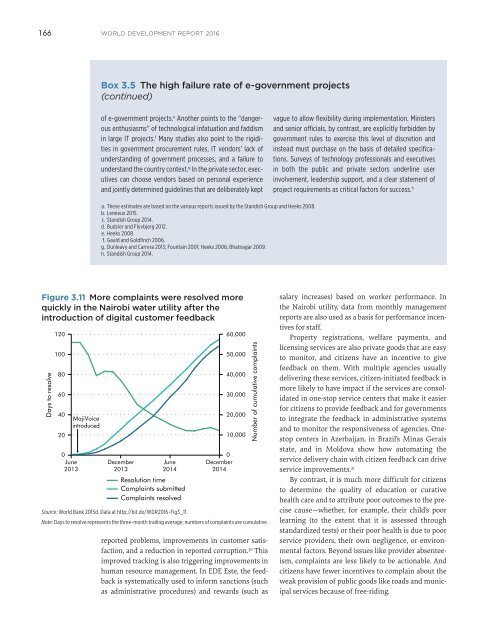Authorized Authorized
eERqs
eERqs
Create successful ePaper yourself
Turn your PDF publications into a flip-book with our unique Google optimized e-Paper software.
166 WORLD DEVELOPMENT REPORT 2016<br />
Box 3.5 The high failure rate of e-government projects<br />
(continued)<br />
of e-government projects. e Another points to the “dangerous<br />
enthusiasms” of technological infatuation and faddism<br />
in large IT projects. f Many studies also point to the rigidities<br />
in government procurement rules, IT vendors’ lack of<br />
understanding of government processes, and a failure to<br />
understand the country context. g In the private sector, executives<br />
can choose vendors based on personal experience<br />
and jointly determined guidelines that are deliberately kept<br />
vague to allow flexibility during implementation. Ministers<br />
and senior officials, by contrast, are explicitly forbidden by<br />
government rules to exercise this level of discretion and<br />
instead must purchase on the basis of detailed specifications.<br />
Surveys of technology professionals and executives<br />
in both the public and private sectors underline user<br />
involvement, leadership support, and a clear statement of<br />
project requirements as critical factors for success. h<br />
a. These estimates are based on the various reports issued by the Standish Group and Heeks 2008.<br />
b. Lemieux 2015.<br />
c. Standish Group 2014.<br />
d. Budzier and Flyvbjerg 2012.<br />
e. Heeks 2008.<br />
f. Gauld and Goldfinch 2006.<br />
g. Dunleavy and Carrera 2013; Fountain 2001; Heeks 2006; Bhatnagar 2009.<br />
h. Standish Group 2014.<br />
Figure 3.11 More complaints were resolved more<br />
quickly in the Nairobi water utility after the<br />
introduction of digital customer feedback<br />
Days to resolve<br />
120<br />
100<br />
80<br />
60<br />
40<br />
20<br />
0<br />
June<br />
2013<br />
MajiVoice<br />
introduced<br />
December<br />
2013<br />
June<br />
2014<br />
Resolution time<br />
Complaints submitted<br />
Complaints resolved<br />
0<br />
December<br />
2014<br />
60,000<br />
50,000<br />
40,000<br />
30,000<br />
20,000<br />
10,000<br />
Source: World Bank 2015d. Data at http://bit.do/WDR2016-Fig3_11.<br />
Note: Days to resolve represents the three-month trailing average; numbers of complaints are cumulative.<br />
Number of cumulative complaints<br />
reported problems, improvements in customer satisfaction,<br />
and a reduction in reported corruption. 30 This<br />
improved tracking is also triggering improvements in<br />
human resource management. In EDE Este, the feedback<br />
is systematically used to inform sanctions (such<br />
as administrative procedures) and rewards (such as<br />
salary increases) based on worker performance. In<br />
the Nairobi utility, data from monthly management<br />
reports are also used as a basis for performance incentives<br />
for staff.<br />
Property registrations, welfare payments, and<br />
licensing services are also private goods that are easy<br />
to monitor, and citizens have an incentive to give<br />
feedback on them. With multiple agencies usually<br />
delivering these services, citizen-initiated feedback is<br />
more likely to have impact if the services are consolidated<br />
in one-stop service centers that make it easier<br />
for citizens to provide feedback and for governments<br />
to integrate the feedback in administrative systems<br />
and to monitor the responsiveness of agencies. Onestop<br />
centers in Azerbaijan, in Brazil’s Minas Gerais<br />
state, and in Moldova show how automating the<br />
service delivery chain with citizen feedback can drive<br />
service improvements. 31<br />
By contrast, it is much more difficult for citizens<br />
to determine the quality of education or curative<br />
health care and to attribute poor outcomes to the precise<br />
cause—whether, for example, their child’s poor<br />
learning (to the extent that it is assessed through<br />
standardized tests) or their poor health is due to poor<br />
service providers, their own negligence, or environmental<br />
factors. Beyond issues like provider absenteeism,<br />
complaints are less likely to be actionable. And<br />
citizens have fewer incentives to complain about the<br />
weak provision of public goods like roads and municipal<br />
services because of free-riding.


